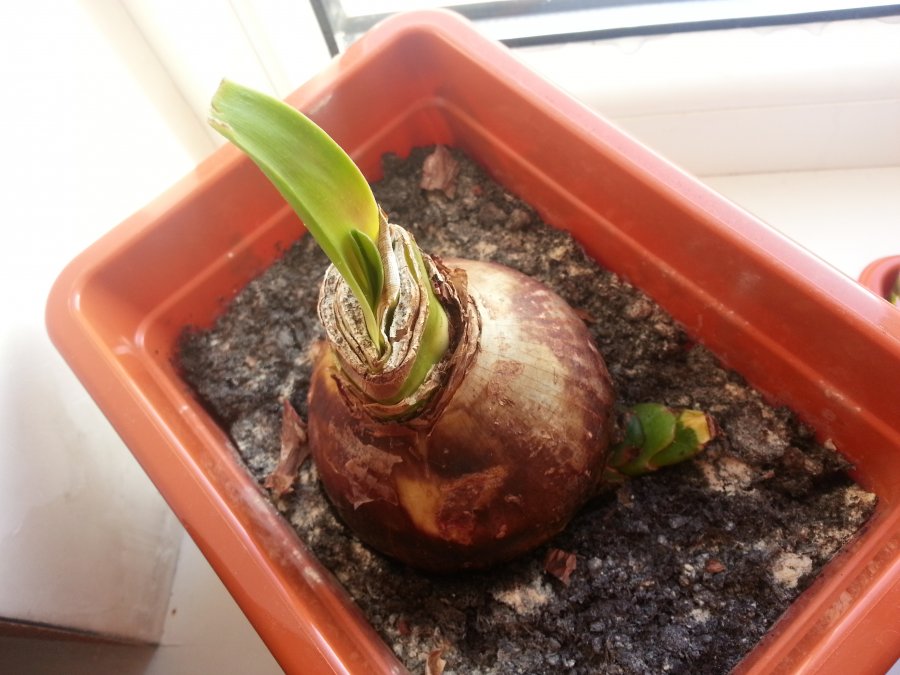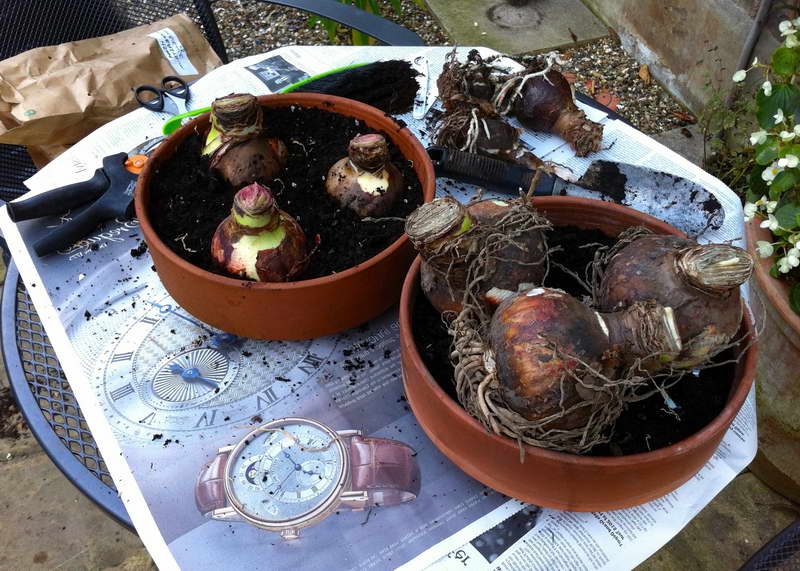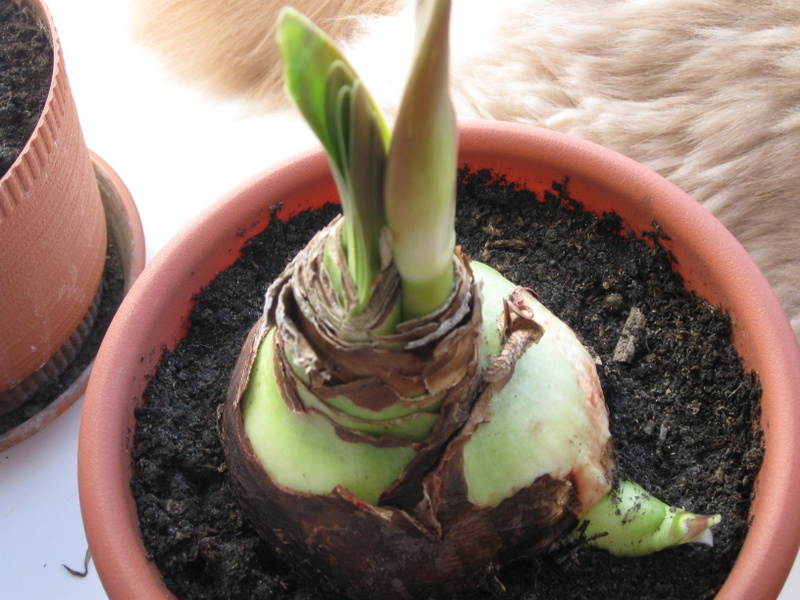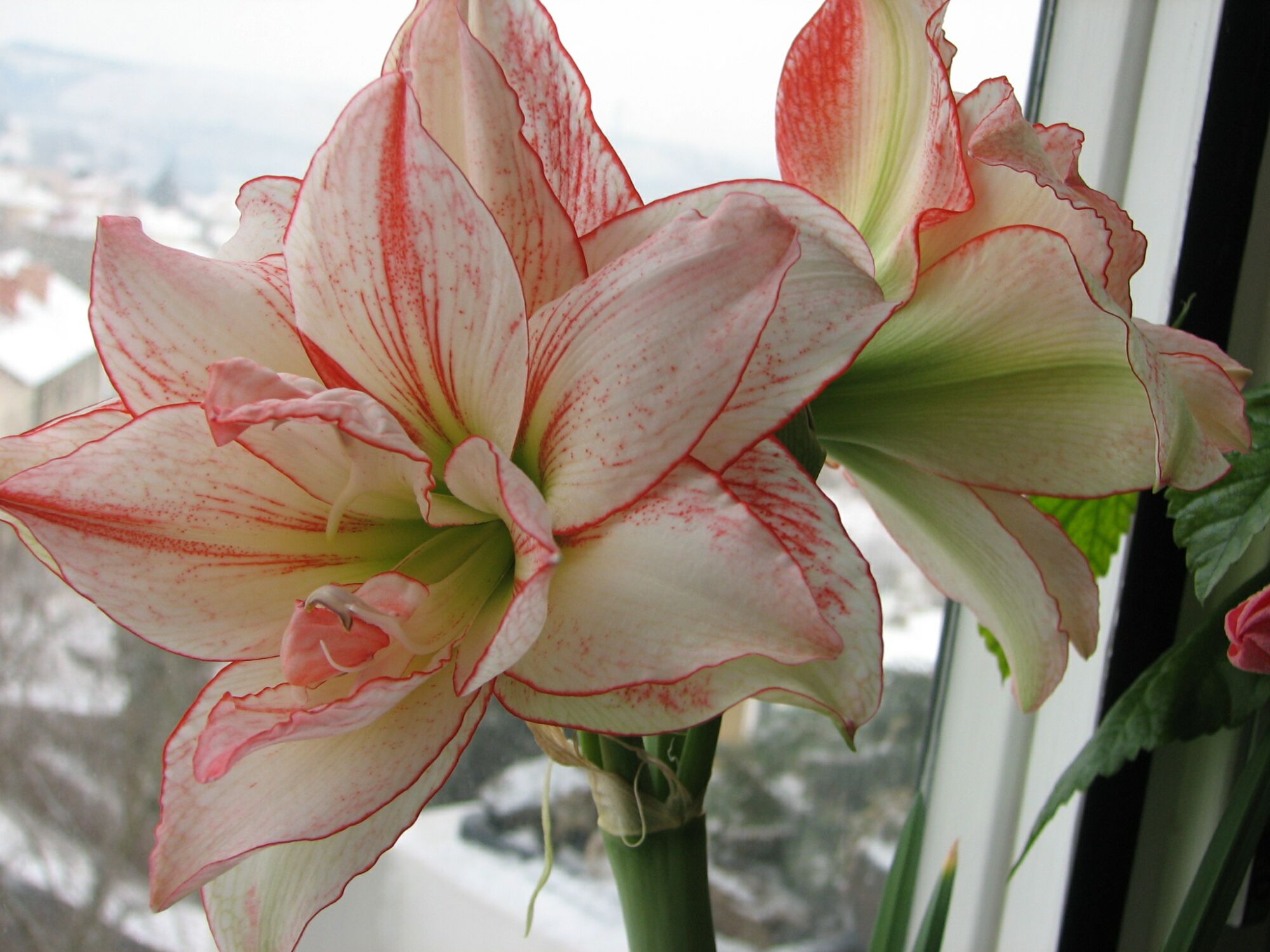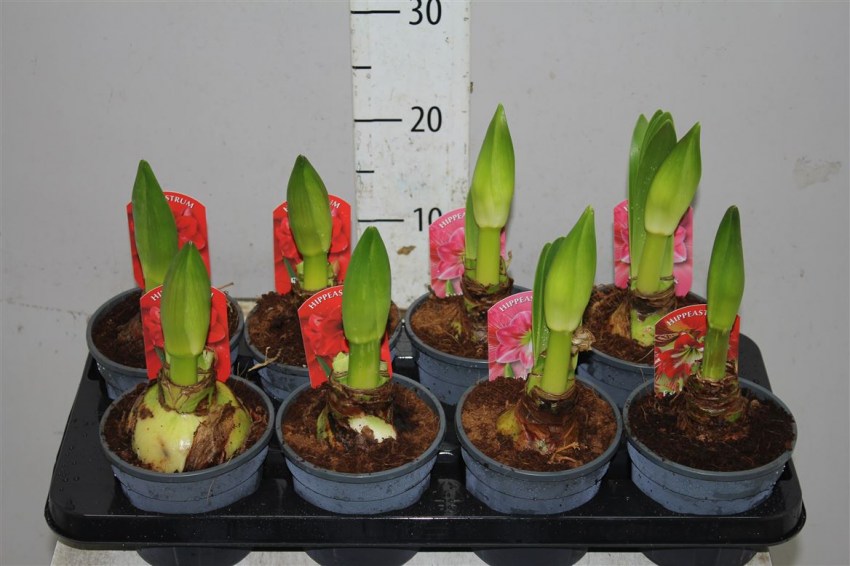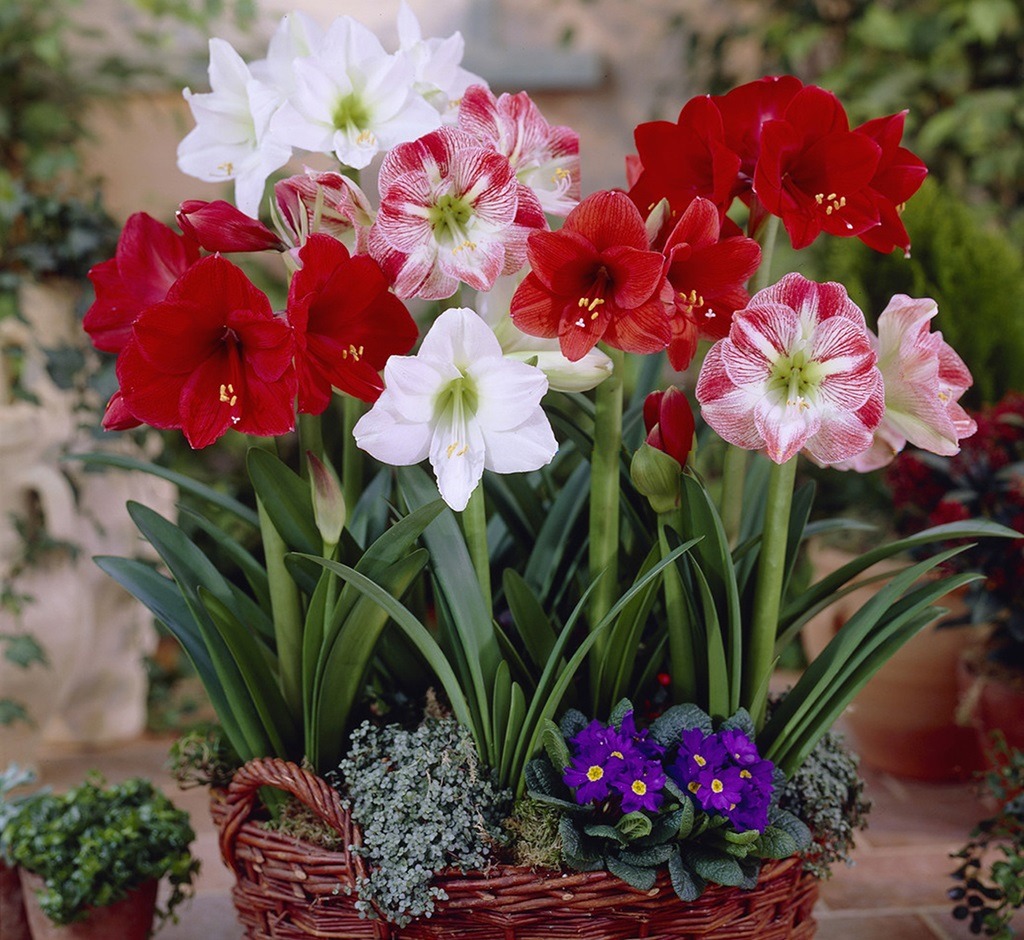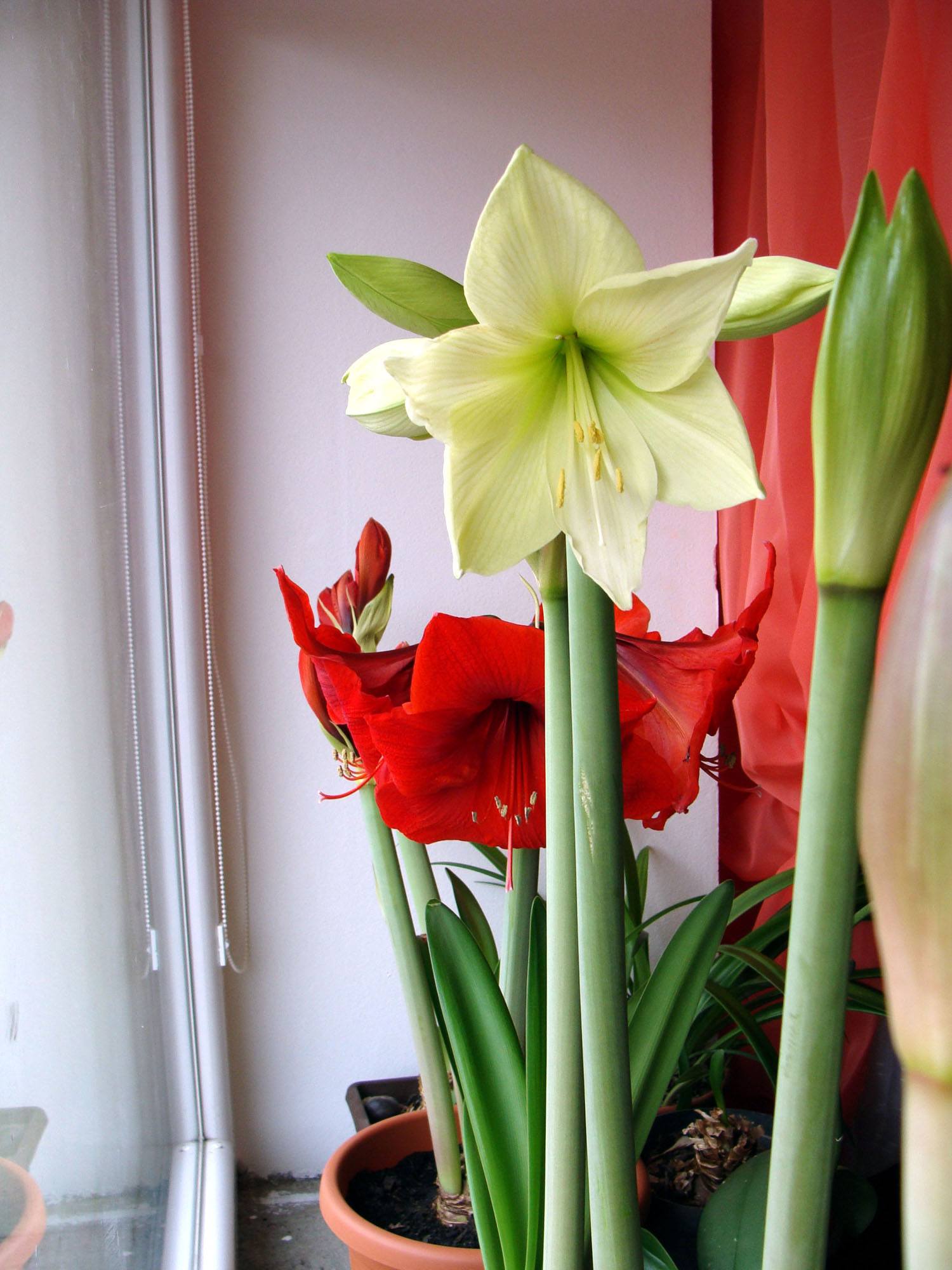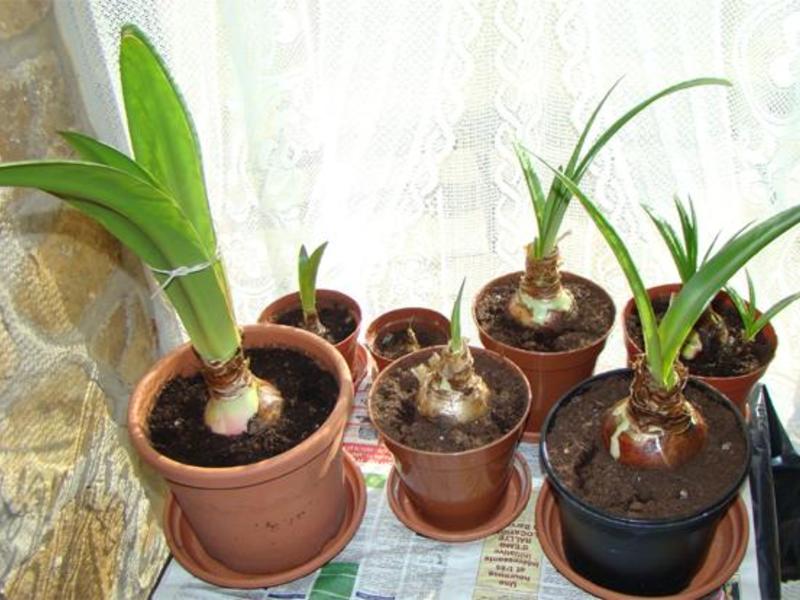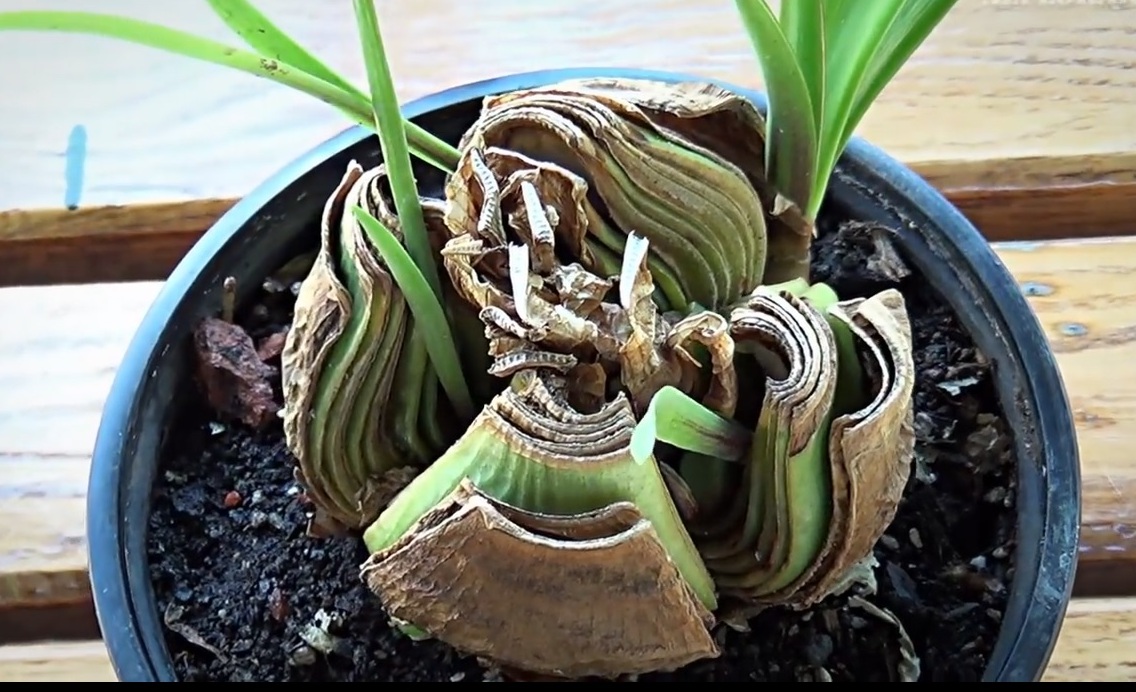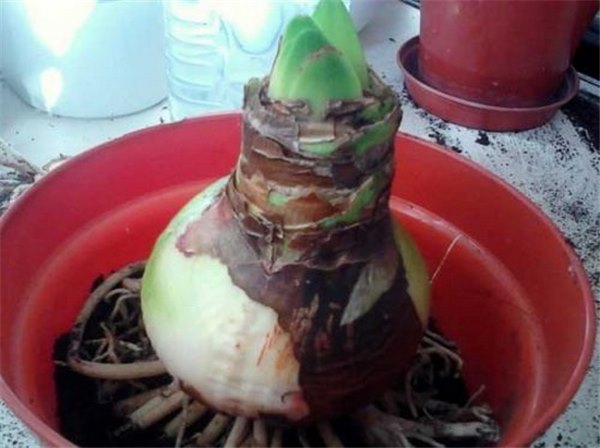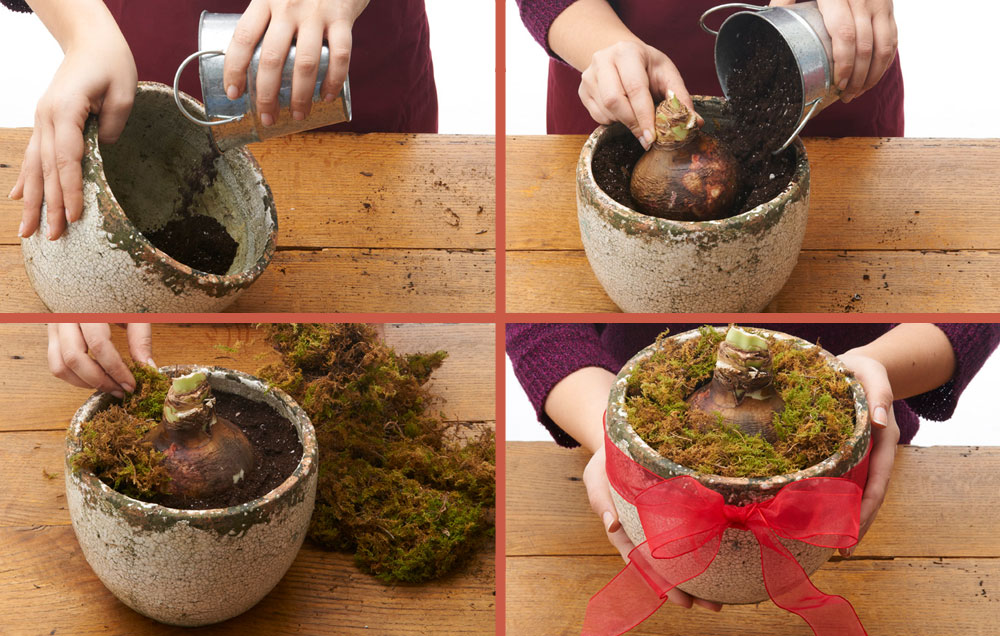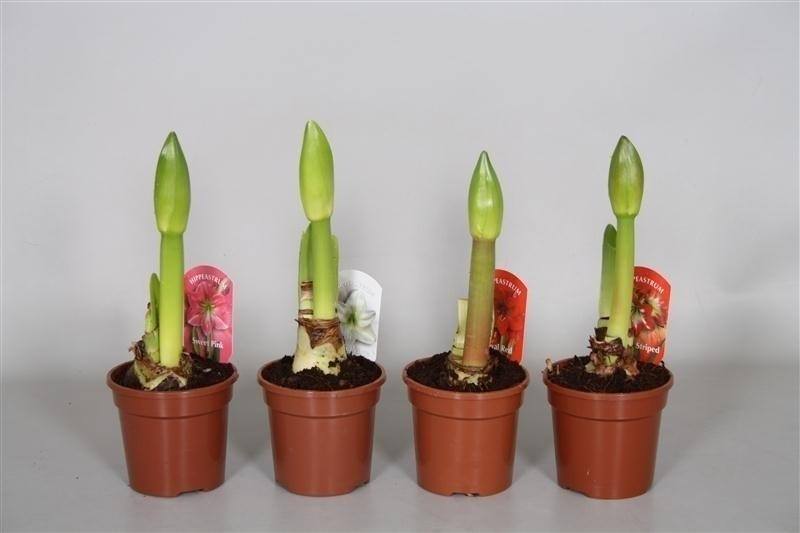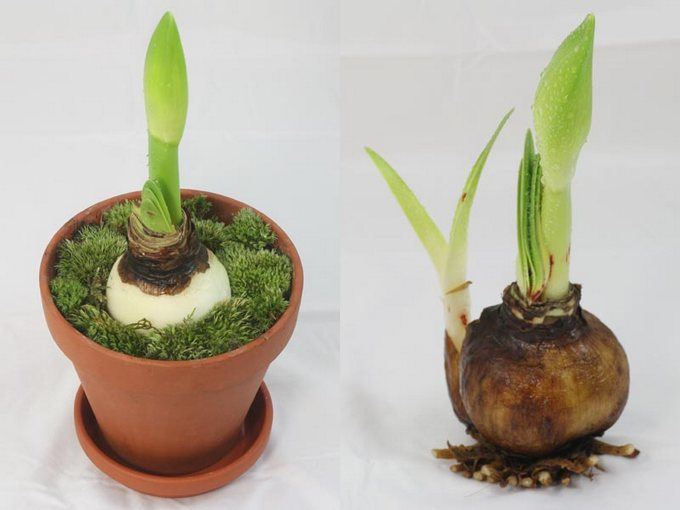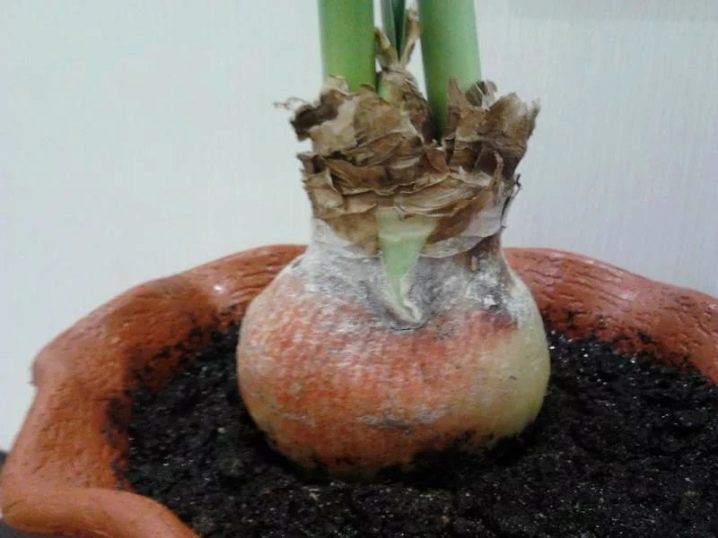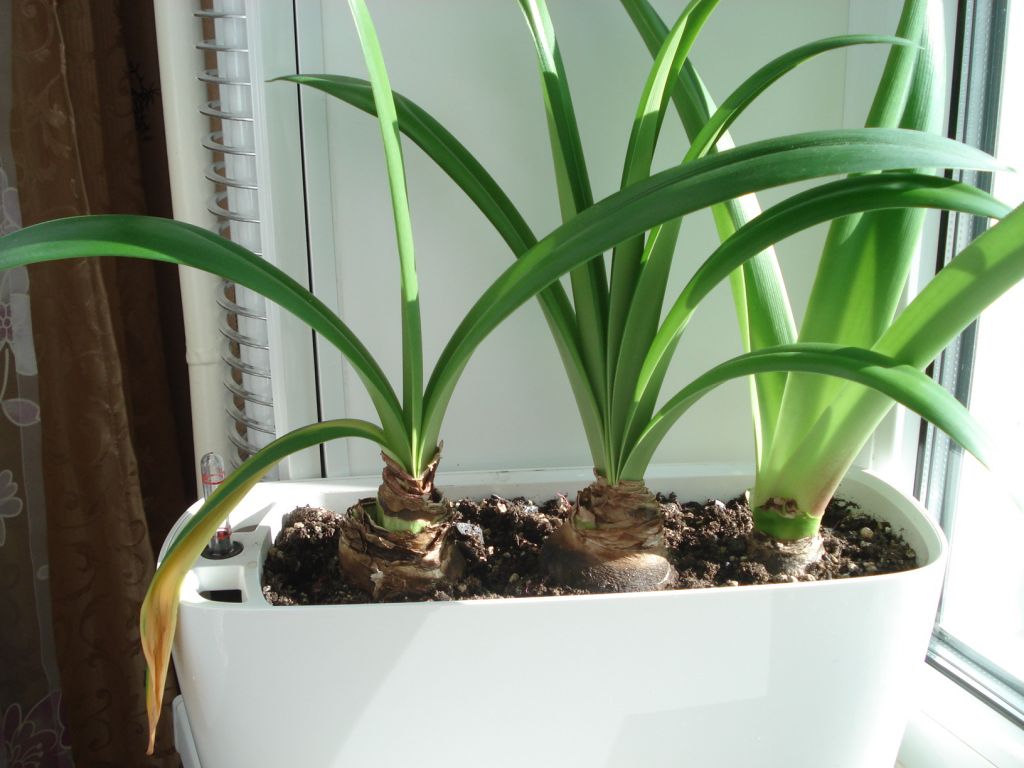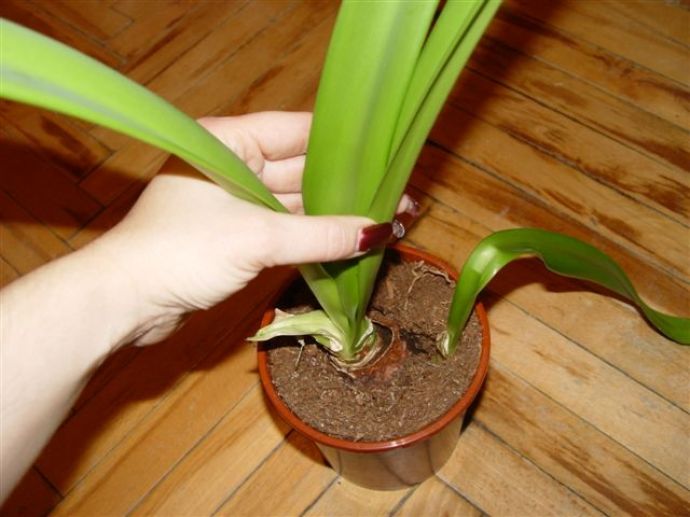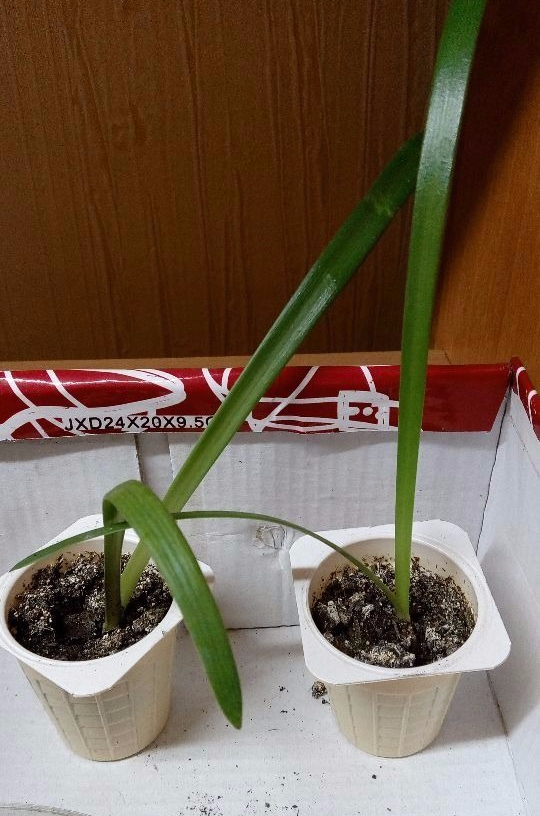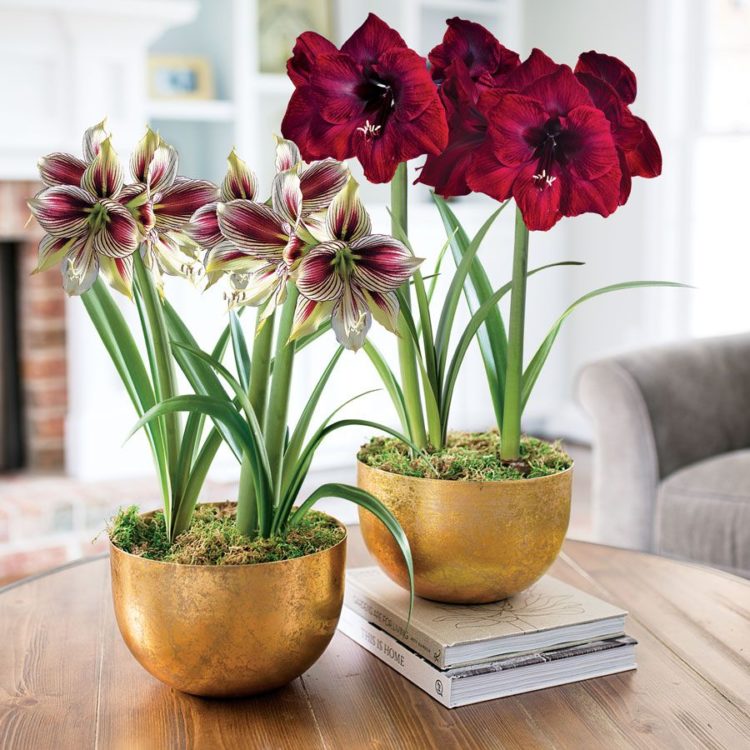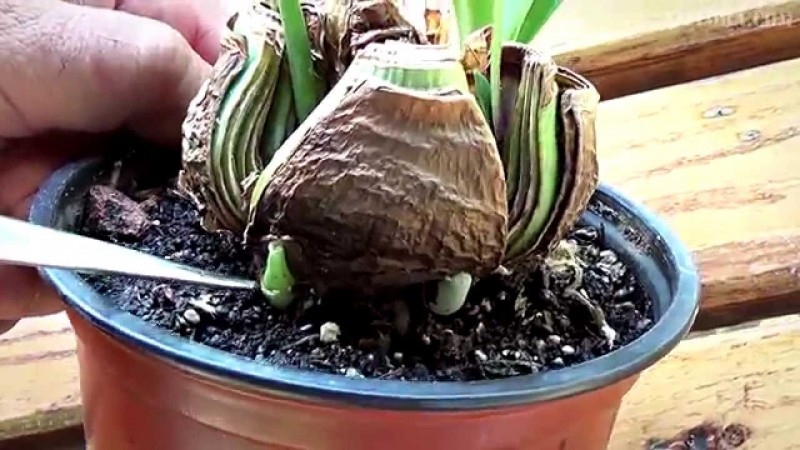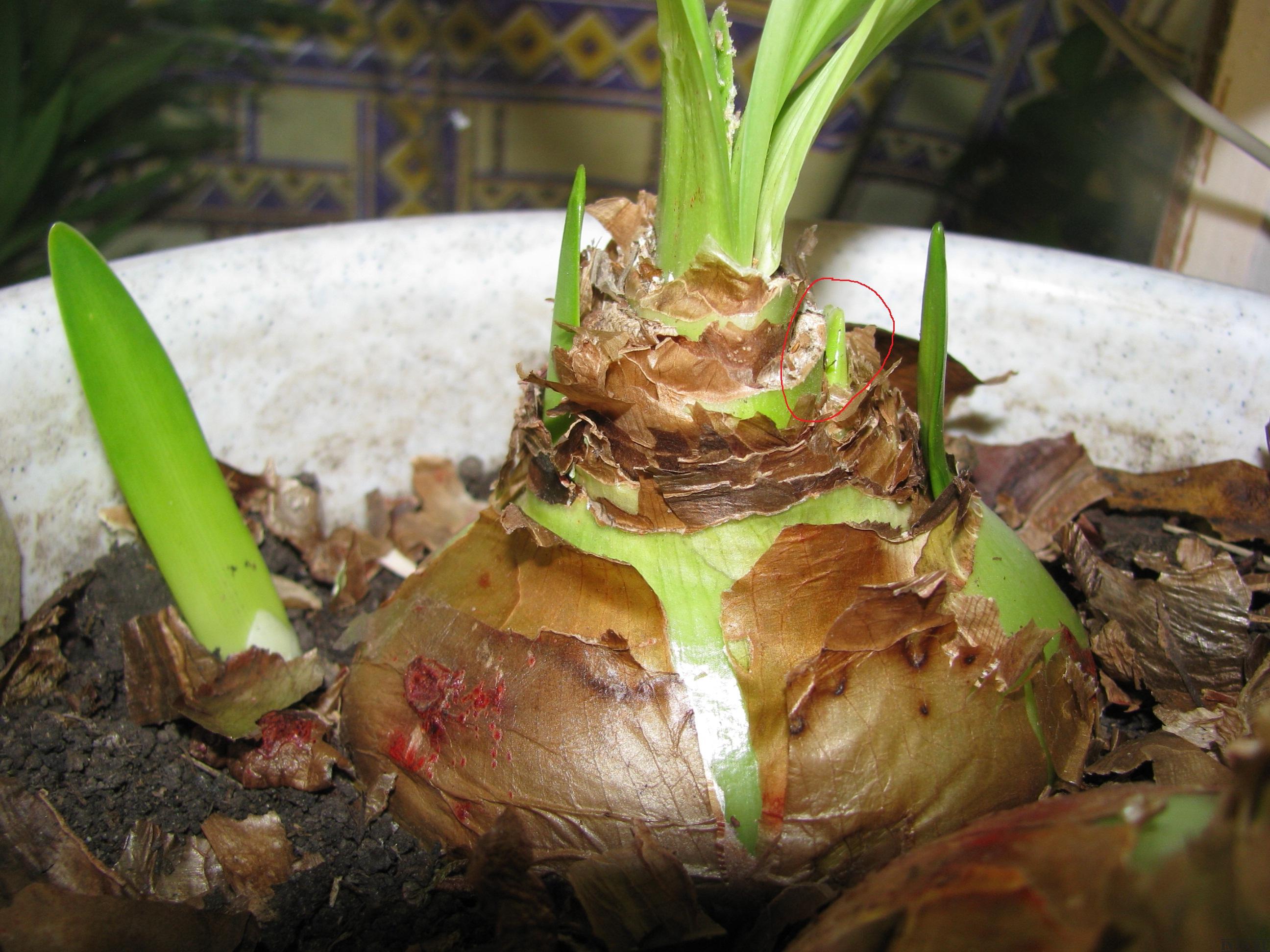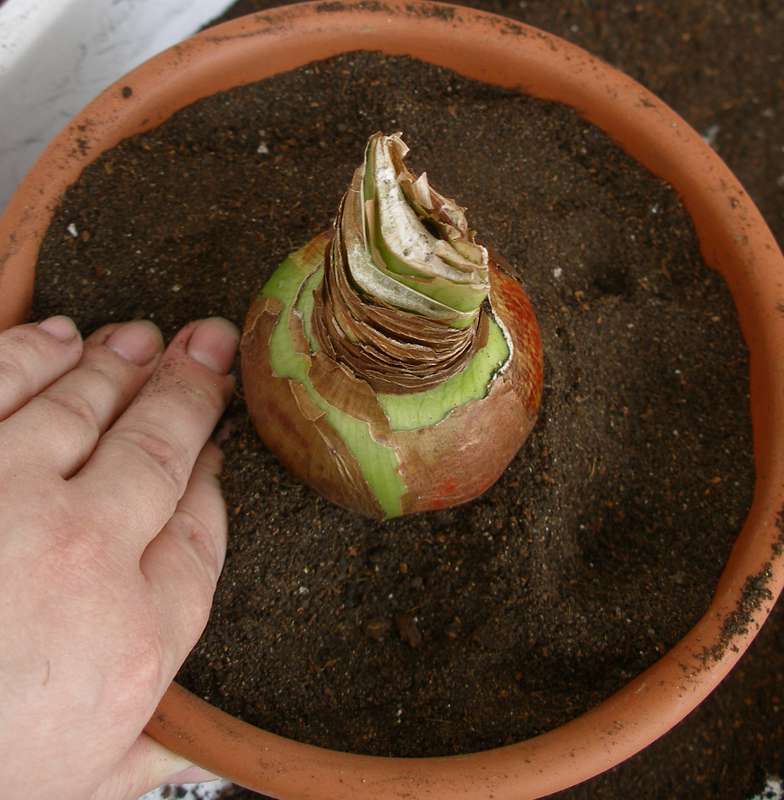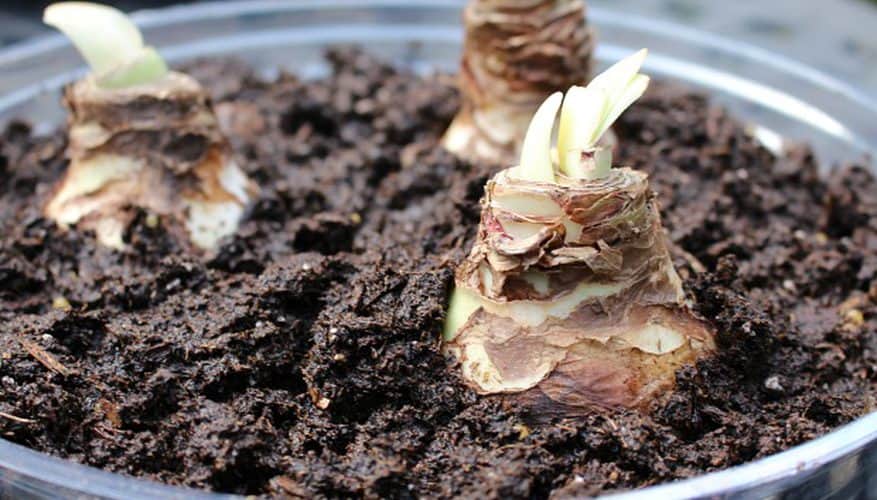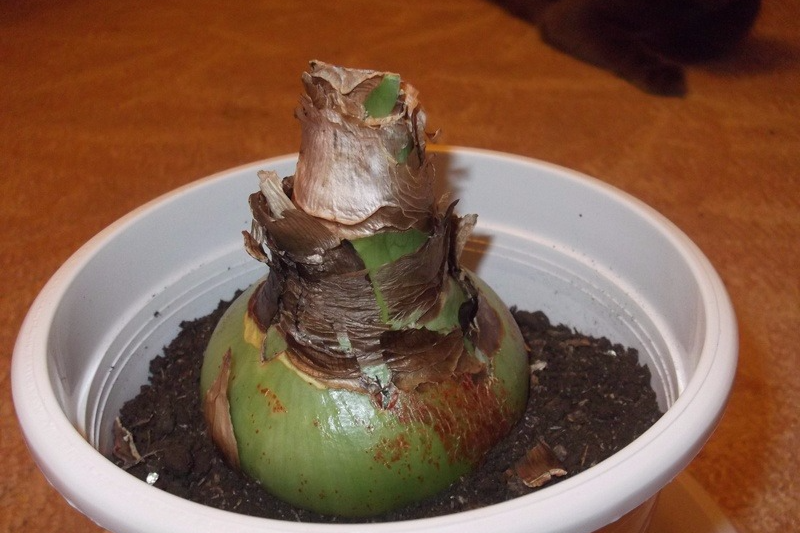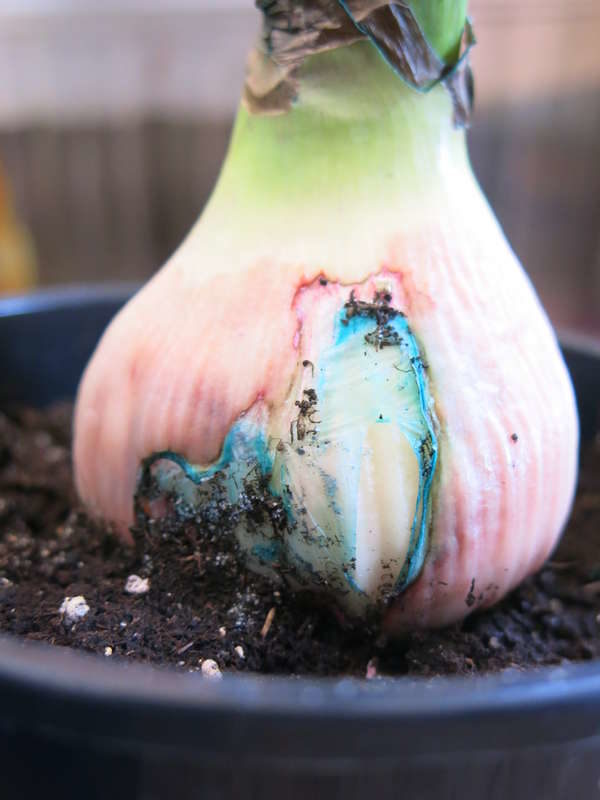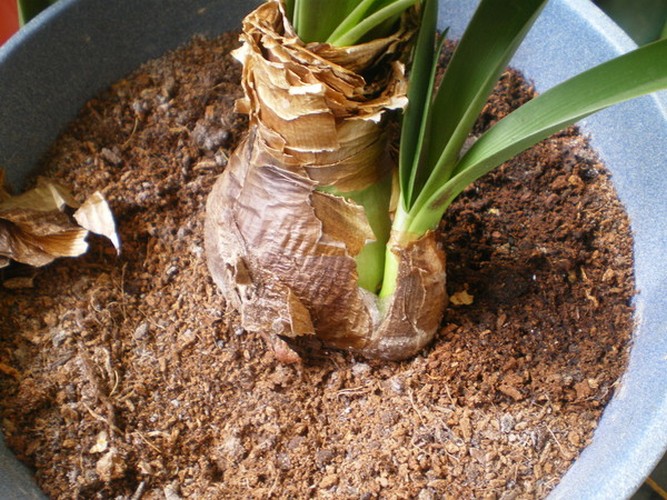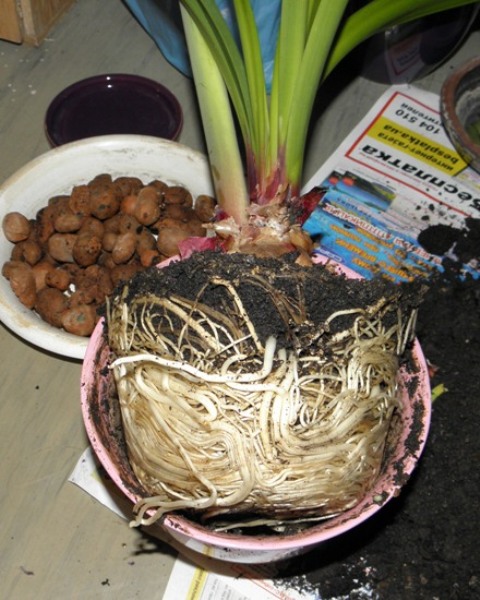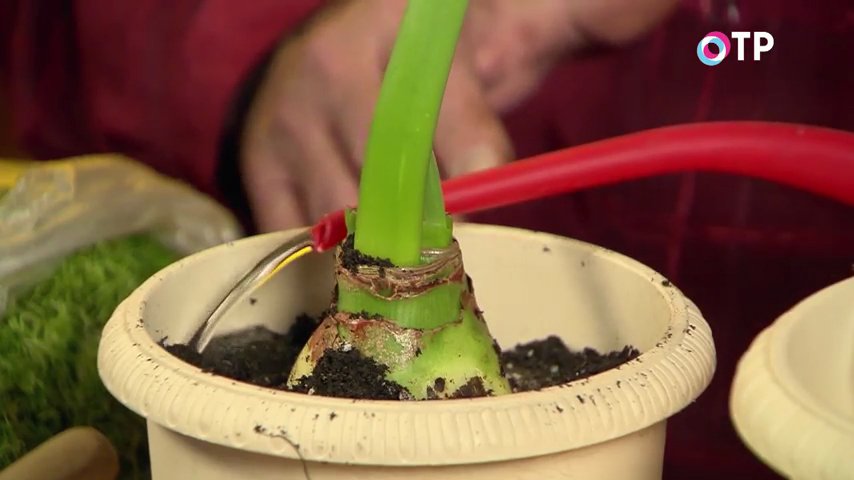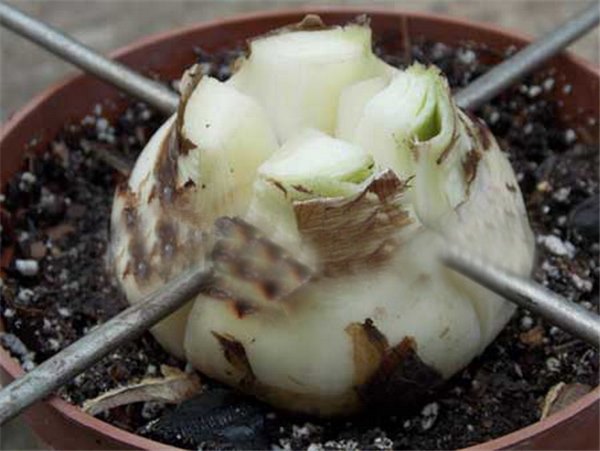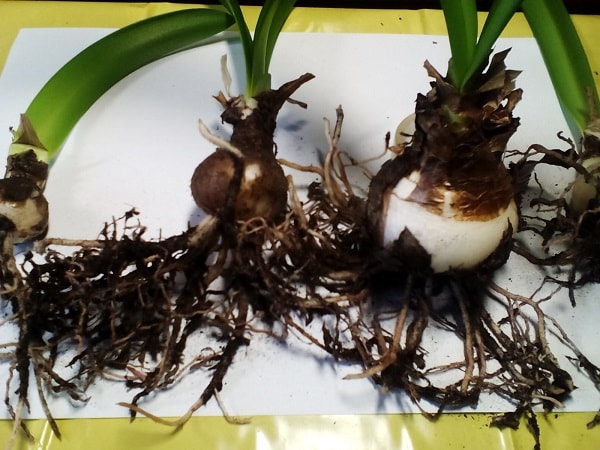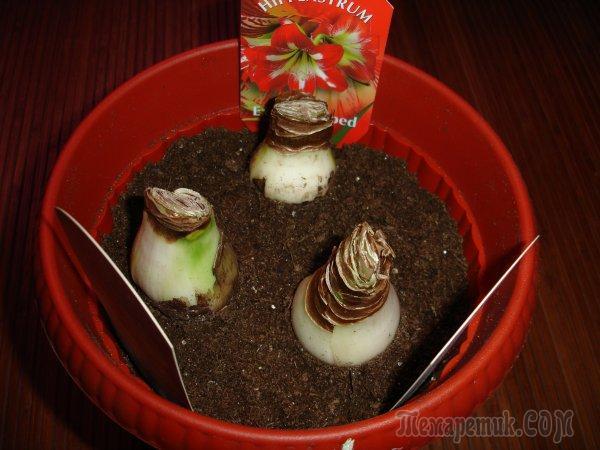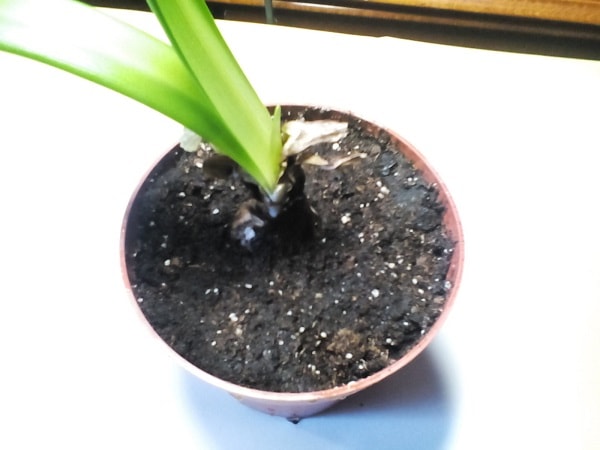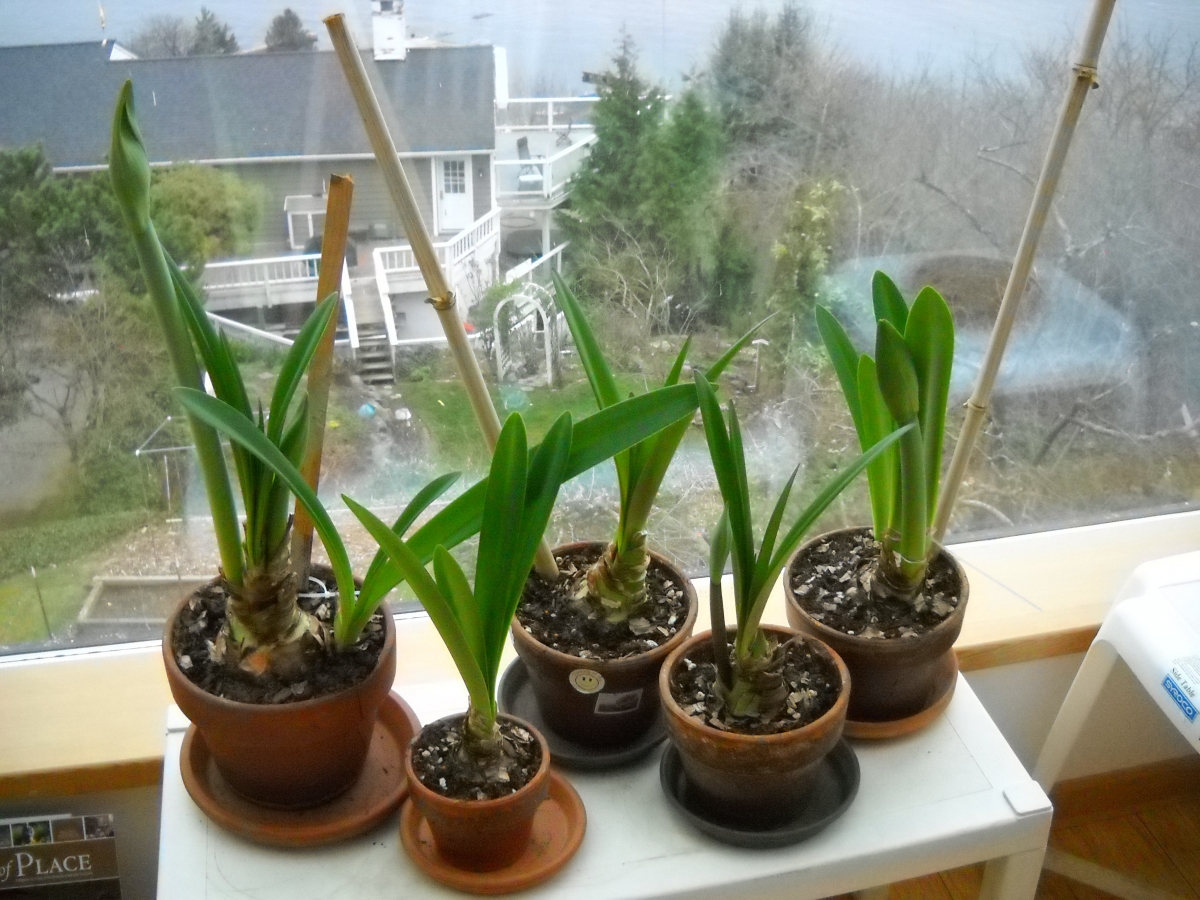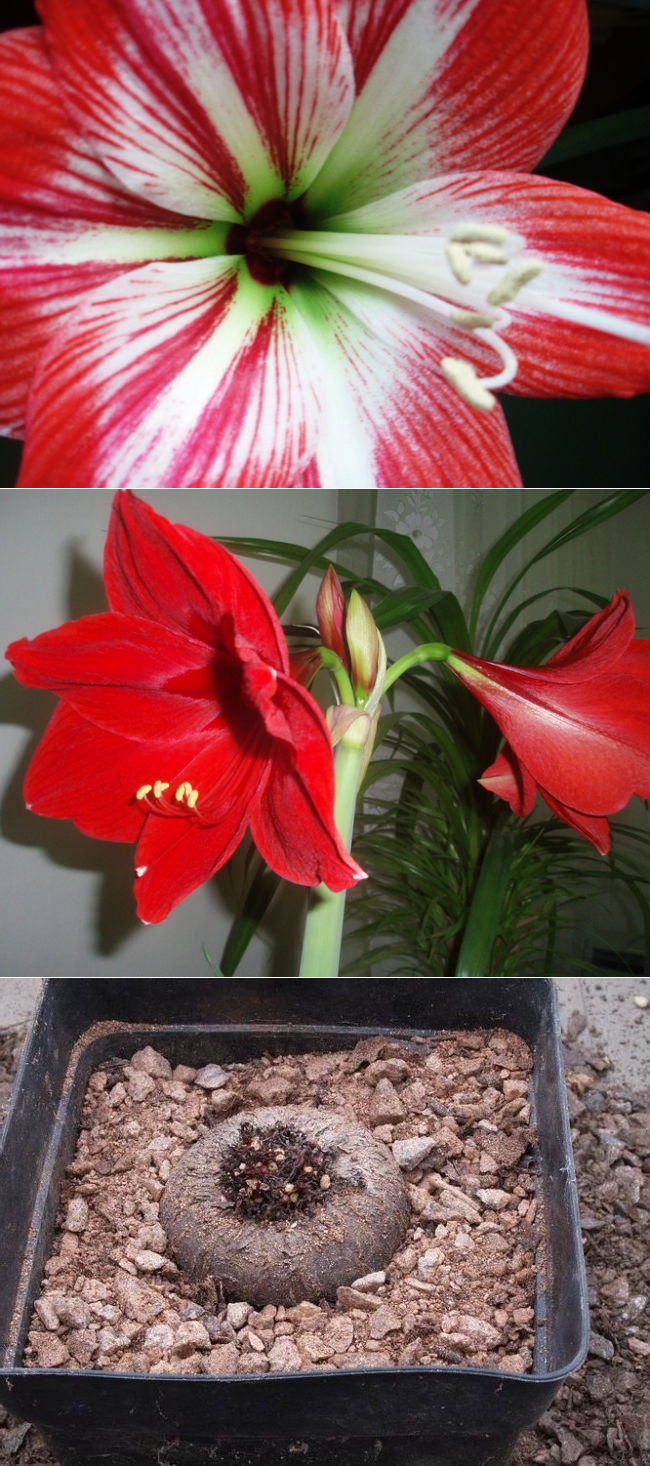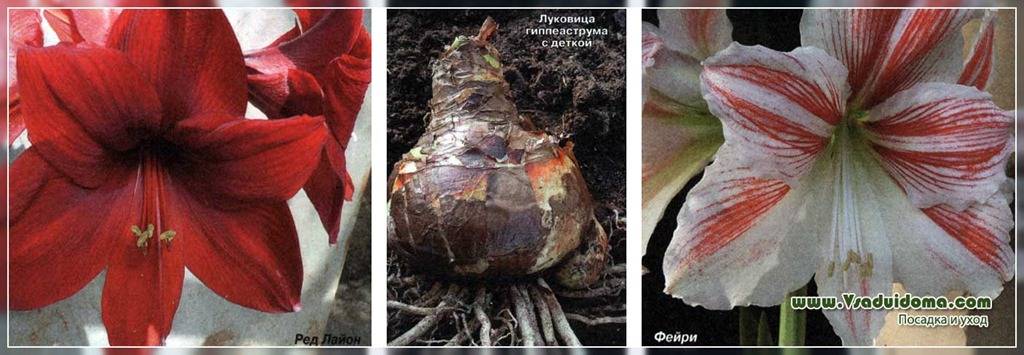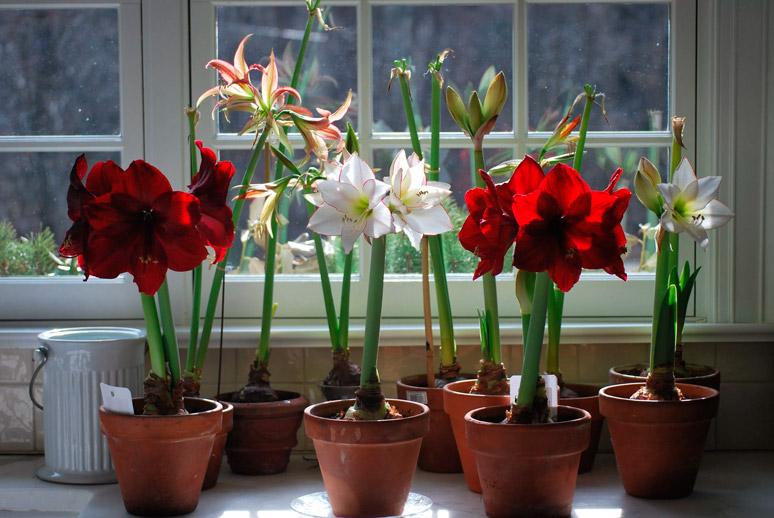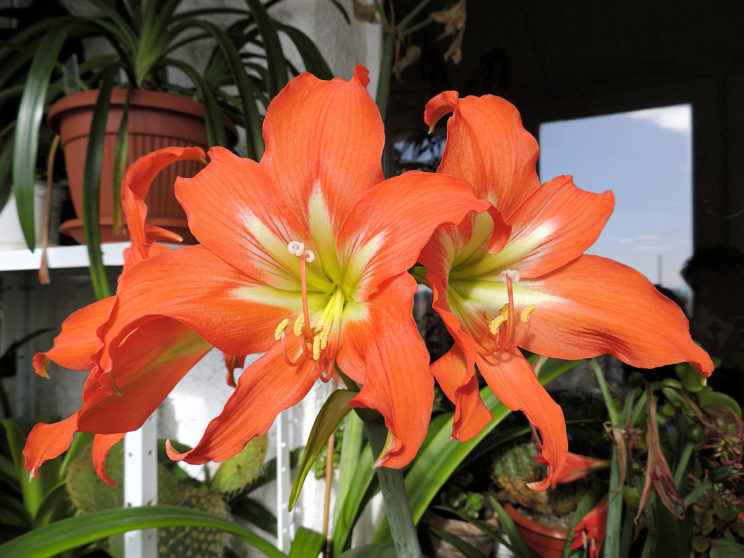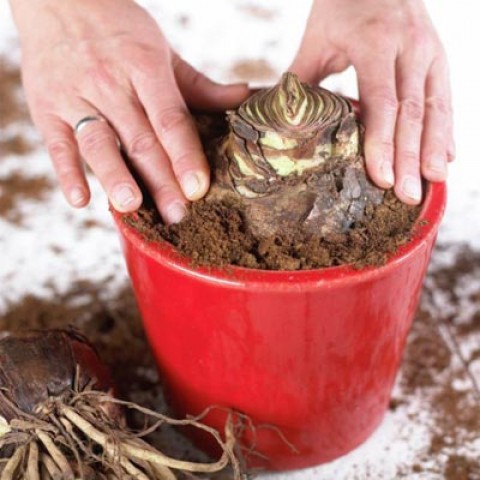Possible growing problems
The flower is highly immune to most diseases. However, this does not exclude possible problems that arise from improper care.
Diseases and pests
The indoor flower is affected by downy mildew, red rot and red burn fungus. In addition, it can be attacked by a variety of pests (for example, aphids, spider mites, scale insects), which are eliminated with insecticides.
Having identified the disease at an early stage, you can quickly eliminate it and save the plant from death. Each ailment has its own signs and methods of struggle:
- Fungal burn. The surface of the bulb and leaves is covered with red spots. The infected plant is dug up, all affected parts are removed and the sections are treated with a special mixture (vitriol and chalk in a ratio of 1:20). Then the onion is dried for 7 days in the open air. After all the procedures, it is planted in a new soil, which is pre-treated with a fungicide.
- Powdery mildew. The disease is indicated by a whitish bloom covering the green part of the plant. Hippeastrum is treated with specialized products that are sold in a flower shop.
- Rot. The affected areas are eliminated, the bulb is dried and prepared for replanting. However, it is pretreated with Fundazol.
 Improper care leads to the development of flower diseases
Improper care leads to the development of flower diseases
Reasons for the lack of flowering
If the flower refused to release the peduncle, then you should pay attention to the following factors:
- Watering frequency. Stagnation of moisture provokes rotting of the bulb.
- Top dressing mode. For flowering, a plant requires strength. Hippeastrum actively absorbs nutrients from the soil. Without additional nutrition, the bulb will weaken.
- Pest attack. The flower directs all its forces to fight insects and recover from insecticide treatment.
Problems waking up after wintering
The dormant period is very important for the flower, as the bulb gains strength for the subsequent growing season. There are situations when the flower does not wake up. Many people recommend to be patient and wait a little longer. However, experienced flower growers know that this is a bad tactic - a hippeastrum that is late with awakening will not fully develop and bloom. Having analyzed the state of the flower at the moment of retirement, it is possible to determine the reasons for the delay in awakening:
- if the green mass was not sufficiently developed, then the bulb will be weak;
- the formation of the peduncle occurs at the level of every fourth leaf. If last season there were only three leaves, then with a high probability the plant will not bloom.
In both cases, the soil is actively moistened and stimulated with nutrients, and the culture is kept warm.
Hippeastrum will create a festive mood when other flowers are still dormant. Bright voluminous buds will fill the apartment with coziness and will be a great addition to an elegant interior.
The rest period of the hippeastrum
The dormant period of the plant begins in September and lasts until January. The subsequent flowering depends on how well the hippeastrum will be prepared for this period.
How to prepare a plant
From late August to early September, you need to gradually reduce the regularity and abundance of watering and fertilization, completely stopping feeding and watering the flower by the end of October and early November. The deadline is December. After a decrease in watering and a natural reduction in daylight hours, all leaves should die off by the beginning of winter.
You should not cut off dry leaves - they give nutrients to the bulb, contributing to their preservation for later flowering.
How to store
While at rest, the bulbs retain their living roots, so you need to continue to water them in moderation no more than 1 time per month. Vases with dormant bulbs should be kept in a dark and dry place for at least 8-10 weeks at a temperature of + 12-14 ° C.
If there are 1-2 green leaves on the bulb that do not interfere with the storage of the pot with hippeastrum, you can leave them by gently bending
If there is little storage space, they should be carefully cut off at the base of the bulb.
How to wake up after rest
To awaken a flower, you need to put it on a light window and gradually resume the irrigation and fertilization regime.
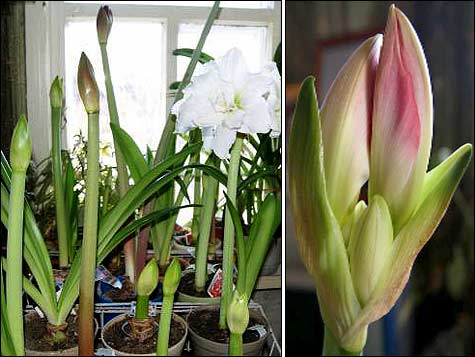
Reproduction of hippeastrum
There are several breeding methods:
- Vegetative method. It boils down to separating and placing the bulbs in the soil after they appear on their adult "brethren". The baby is planted in a small container and eventually transplanted into a more spacious one. The first peduncle appears after at least 3 years.
- Another method is to divide the onion into equal parts (from 2 to 8). Each blank must have roots. The slices need to be covered with charcoal, placing it in the places of the cuts, and then - planted in the soil.
- Reproduction by seeds. This method is more difficult than the previous one. Moreover, it is difficult to reproduce one variety, since most of the hippeastrum is hybrids. To propagate hippeastrum, you need to move pollen from the stamens of a blooming plant to the stigma of another (twice on sunny days).
Attention: the juice of the bulbs is poisonous! Even a small amount of it ingested can cause gastrointestinal upset. Manipulations are best performed with gloves and avoid contact of the bulbs with the skin and mucous membranes.
If everything is done correctly and fertilization has occurred, then from the main flower, at the end of flowering, a box with seeds will appear.
Transfer
It is recommended to transplant young hippeastrum once a year, adults - once every 2-3 years.
The optimal time for transplanting is August or December - that is, at the beginning or at the end of the dormant period. It is recommended to replace the topsoil annually for adult specimens.
The pot for the hippeastrum should be deep and low, its diameter should exceed the diameter of the bulb by 5-7 cm. Ceramic stable containers with holes for water drainage are preferred. Such a pot will prevent stagnation of water in the soil and, accordingly, rotting of the root system, and will also contribute to the lush flowering of the plant, and not the growth of green mass and daughter bulbs.
First, a 2-3 cm pot is filled with drainage, then - with a disinfected earth mixture, consisting of equal parts of sod land, humus, sand and peat
A very important condition for a hippeastrum transplant is a correct fit. The bulb goes deep into the ground by a maximum of 2/3 of its height, otherwise the plant will develop poorly, it may hurt, and will not bloom
The best way to transfer is transshipment. Thus, the root system is damaged as little as possible, the plant takes root faster and starts growing.
When transplanting, it is important to inspect the bulb and roots for damage. If available, they are trimmed with a sharp, sterile knife.
If the bulb itself is damaged, then after pruning it should be soaked for 30 minutes in a fungicide solution, for example, Fundazol or Maxim, and then dried for a day.
Then such a reanimated bulb is planted in the ground, while deepening no more than ¼ of its height. This will help control her condition. After the final recovery, the earth can be filled up a little.
Transplantation is not necessary immediately after purchase. Also, it should not be carried out during flowering. It is only possible to replace the top layer of the earth.
Home care for hippeastrum
Despite its tropical origin, the plant takes root well on an apartment windowsill.The main rule of success is to create optimal conditions of detention.
Illumination and temperature conditions
The plant thrives on the east or southeast window, where it receives a sufficient amount of diffused light. If the windows of the apartment face south or west, then at the peak of solar activity, the flower is shaded. The north side is categorically not suitable for the cultivation of hippeastrum - in insufficient light, it will not be able to form a flower.
The key to the health of a flower is careful observance of the optimal temperature regime. During the cold season, the temperature should be kept in the range of + 13-18 ° C. The growing season should take place at a temperature of +25 ° C.
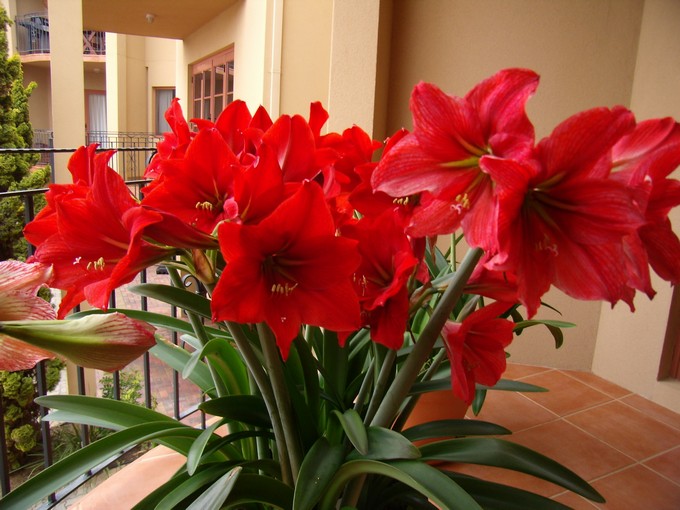 In summer, a flowerpot with a flower can be taken out to the balcony
In summer, a flowerpot with a flower can be taken out to the balcony
The choice of soil and flower pot
The plant will not actively develop in conditions of unsuitable soil. You can purchase specialized soil for bulb flowers at your gardening store. It is also prepared independently from turf, peat, sand and humus (2: 1: 1: 1).
Hippeastrum prefers loose soil, therefore vermiculite or coconut substrate is often added to the soil mixture.
Author's advice
The peculiarity of the root system, namely its power, dictates the conditions when choosing a pot. The bulb should be placed at a distance of 25 mm from the walls of the container, with a thick drainage layer at the bottom. Therefore, a tall and narrow pot is ideal for a hippeasturm.
Watering and spraying
With the onset of January, the hippeastrum awakens from sleep, while it is gradually accustomed to light. The first watering is carried out after the formation of the arrow. At this stage, a small amount of water is added so as not to provoke excessive foliage growth. During the period of active flowering, the plant is watered abundantly until September. When the hippeastrum is preparing for wintering, the volume of the applied liquid is reduced.
The flower feels great at home, but it still comes from the tropics, so it does not favor excessively dry air. Spraying from a spray bottle is not advisable when flowering. Moistened expanded clay will help to increase the humidity, on which a pot with hippeastrum is installed.
 The first watering is carried out after the formation of the arrow
The first watering is carried out after the formation of the arrow
Feeding rules
Correctly selected and timely applied nutrients help the plant to bloom beautifully. The first feeding is carried out when the arrow reaches a height of 15 cm.Then it is recommended to fertilize the hippeastrum every 3 weeks.
The flower prefers phosphorus-potassium substances, which contribute to abundant flowering. Regardless of the company, all fertilizers are diluted with water (1: 2). It is undesirable to use nitrogen fertilizers for feeding the crop - they can provoke gray rot.
Subtleties of transplant
The procedure is carried out a month after flowering or at the beginning of January. An adult plant is recommended to renew the soil and pot every 2.5 years. Also replace the top layer of the substrate, as the bulb quickly absorbs nutrients. When transplanting, the bulb is deepened in half so that the upper part can sprout. The first feeding is carried out after 14 days.
Post-flowering care
It is necessary to take care of the plant correctly, not only during the growing season. The splendor of flowering next year depends on the dormant period. With the onset of September, the soil is stopped to moisten. When the foliage and peduncle are dry, they are carefully trimmed. The flower itself is hidden in a dry, dark place, where it is stored until January.
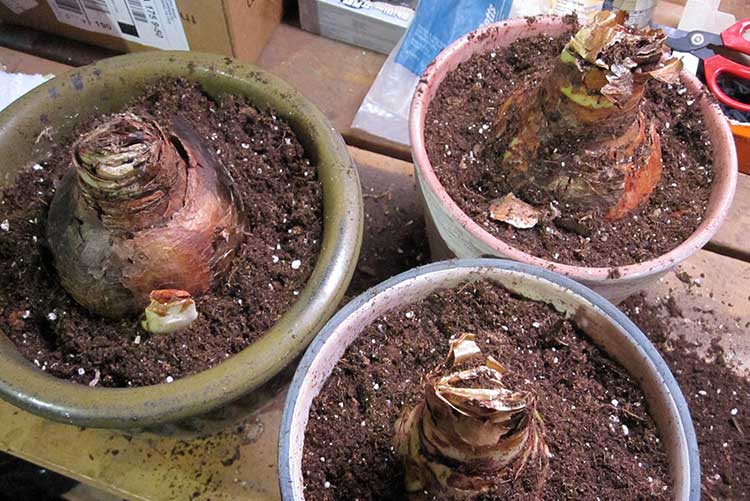 Dry peduncles and leaves are carefully trimmed
Dry peduncles and leaves are carefully trimmed
Reproduction methods
What kind of breeding hippeastrum is easier and more effective? The first and second methods are used more often, the third is very rare: for the germination of seed, artificial pollination and freshly harvested seeds are required.
Children
During transplantation, a small element is carefully separated from the large parent bulb. The instrument is sterilized, the cut is disinfected with charcoal powder
After planting in an individual container for two years, the leaves are not removed from the growing flower, even during rest.
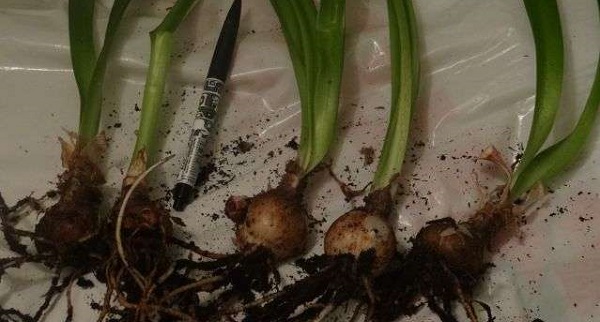
By dividing the bulb
The optimal period is November: by this time the base accumulates the greatest amount of nutrients. After removing the scales, the large onion is divided into 4 parts, but not completely. Then the knitting needles are inserted so that the parts do not touch. The bulb is looked after as if it were an adult tropical specimen. After the leaves have formed, the plant is fertilized. The next year, the bulbs are divided, planted in flowerpots: four new flowers are obtained.
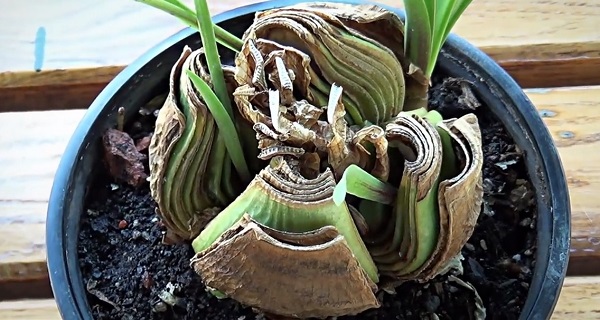
Seeds
The method is complex, laborious, only experienced flower growers can do it.
It is important that the planting material is freshly harvested: for dried seeds, the indicators decrease to 1/3 of the total amount

Choosing a pot for hippeastrum
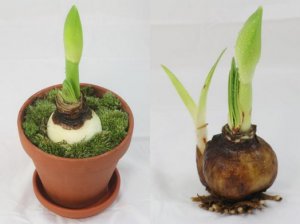 The size of the pot will directly depend on the size of the hippeastrum bulb. Please note: when planting, the bulb should be placed in the middle of the pot, leaving 5 cm to each edge. Thus, the pot for this flower must be at least 15 cm in diameter.
The size of the pot will directly depend on the size of the hippeastrum bulb. Please note: when planting, the bulb should be placed in the middle of the pot, leaving 5 cm to each edge. Thus, the pot for this flower must be at least 15 cm in diameter.
As for the height of the pot, on the contrary, it should not be too large, because the bulb does not need to be completely immersed in the soil (its upper part remains half above the ground). In addition, at the bottom of the pot it will be necessary to lay out drainage from stones, and above it there is still a fairly large layer of soil.
There are no clear restrictions on the material of the container for hippeastrum, but it is still better to use ordinary plastic pots for this plant.
This is due to the fact that ceramics are capable of intense heating in the sun, often causing overheating of the flower bulb. In this case, his death will be inevitable.
Transfer
Home hippeastrum is transplanted into a new flowerpot every three years. Manipulations are carried out during the rest period. At the very beginning or just before the start of growth. A large pot is not required, it is enough that the diameter of the flowerpot is at least four centimeters larger than the size of the onion. The soil should be light and drain moisture well.
The substrate is usually prepared from river or quarry pitch, humus and light, low-fat earth. The soil is disinfected before planting. To do this, it is enough to spill it with a weak solution of potassium permanganate. Expanded clay, gravel or other drainage is laid at the bottom of the flowerpot. Transplanting into another container is carried out by transshipment so as not to injure the roots. The plant is carefully removed along with a lump of earth and placed in a new pot. The bulb should be located so that its upper third is above the surface. Earth is sprinkled around it and hippeastrum is spilled. Home care for a transplanted plant is the same as after a dormant state.
Hippeastrum care
Suitable conditions for growing hippeastrum, especially in autumn, are the optimal combination of temperature, light, humidity levels, which are absolutely opposite during the periods of growth, flowering and dormancy. Its decorative beauty depends on how to care for hippeastrum.
Temperature
Hippeastrum develops at any room temperature, however, the most comfortable for the plant is 20-25 ° C. Avoid temperature extremes that slow down flower growth. During the resting period of the plant (temporary data - in the table with botanical characteristics), do not allow the temperature to drop below 10 ° C.
Illumination
Hyperastrum is a sun-loving flower, it is advisable to place it on the southeast and southwest windows. It tolerates direct sunlight normally, but it is better to provide diffused light to the hippeastrum through transparent tulle. The plant spends eight to ten weeks a year in a dark place, cool (12-14 ° C). This is a dormant period. In order for the hippeastrum to wake up, the pot is placed on a light window.
Peduncles will be even if the flower pot is periodically turned to the sun in different directions
Do this carefully: the hippeastrum, due to the severity of the flower arrows, easily loses its balance and overturns.
Proper watering
The amount of moisture depends on the vegetation stages of the plant. With the onset of the "hibernation" period, watering is stopped until the leaves are completely dry. Only a small amount of water in the pan is allowed to maintain the vitality of the bulb and roots. At the moment of awakening, the amount of moisture is increased to moderate (watered no more than twice a month). With the development of the peduncle, it is necessary to water the hippeastrum systematically and take into account the following features of the procedure:
- use only warm water;
- do not overmoisten the soil;
- make sure that the earthen lump between waterings has time to dry out;
- do not allow water to come into contact with the bulb.
Watering should be as natural as possible: in nature, hippeastrum blooms only in the heavy rains season, and in drought the bulbs "sleep".
Humidity
Hippeastrum, although it grows in the tropics, is a lover of dry content. He does not need spraying and irrigation, since stagonosporosis spreads quickly at high air humidity. This is one of the most dangerous diseases for indoor hippeastrum. At the same time, it is recommended to wipe the juicy, fleshy leaves from dust with a moistened cotton pad.
Priming
For effective cultivation, light and loose soils are needed, with high levels of air and moisture permeability. The following earthen substrate is ideal: in equal proportions peat, river sand and drainage or deciduous soil. A simple solution is to purchase a store-bought begonia soil. After two to three years, it is advisable to completely renew the soil.
The soil mixture should be as nutritious as possible. Expert florists advise adding compost or well-rotted manure to it, as well as a small amount of ash.
Top dressing
Top dressing is very important as the bulb builds up vitality for future flowering. Fertilize hippeastrum every ten days (except for the dormant period). Potash fertilizers are used, the composition of which depends on the stage of plant life:
- the beginning of the growing season - nitrogen-potash in a ratio of 40:60;
- peduncle formation - nitrogen-phosphorus-potassium fertilizing in a ratio of 30:30:40;
- flowering time - phosphorus-potassium fertilizers in a ratio of 40:60.
You cannot fertilize a dry soil mixture, this will only harm the flower. The soil must be watered first. Hippeastrum is well nourished by special solutions for bulbous plants, which are bred strictly according to the instructions. The time for the first feeding is when the flower arrow reaches 10-15 cm.
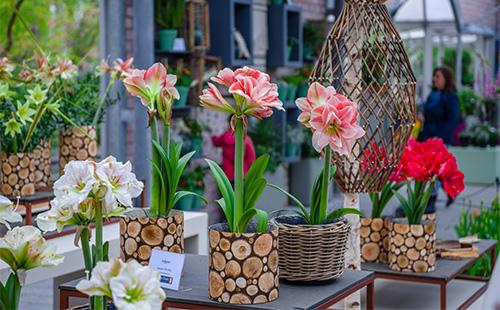
Growing container
The diameter of the bulb of the hippeastrum is on average 10 cm, it has long roots. To grow a flower, you will need a narrow and tall pot, preferably a ceramic one. Focus on the following dimensions: depth - up to 15 cm, width - 5 cm more than the diameter of the bulb. The bottom of the pot must be filled with drainage.
Transfer
It is better to replant hippeastrum in early spring, while completely renewing the soil. It is advised to change the residence of adult plants every two to three years. In summer, the bulbous flower can be transferred to open ground, and with the arrival of autumn, return it to its place. In the first half of September, the plant is dug up, dry scales are cleaned off and must be treated with copper-containing solutions.
The transplant procedure must be performed very carefully so as not to spoil the bulky leaves.
Choosing a soil for hippeastrum
Hippeastrum flowers are quite demanding on the composition of the soil in the pot, so it must be prepared especially carefully.
The most important requirement is the lightness of the soil, which can quickly pass moisture through itself and provide a good air supply to the bulb. It is also important that there is a lot of organic fertilizers in the soil, and the level of its acidity does not exceed 6 pH values.
It is also important that there is a lot of organic fertilizers in the soil, and the level of its acidity does not exceed 6 pH values.It is quite difficult to obtain such a soil mixture by self-mixing, so it is better to go to a specialized store and purchase ready-made soil for bulbous indoor flowers
True, it will not be superfluous to add a little sand to the purchased soil.
It is quite difficult to obtain such a soil mixture by self-mixing, so it is better to go to a specialized store and purchase ready-made soil for bulbous indoor flowers. True, it will not be superfluous to add a little sand to the purchased soil.

If, nevertheless, you decide to prepare the soil mixture for hippeastrum yourself, then use the following components for it (the ratio is indicated in numbers):
- clay-soddy soil (2);
- leafy soil (1);
- humus (1);
- peat (1);
- sand (1).
Rest
When the flower fades, at a certain period it goes into a state of dormancy. At this time, they cut off the yellow foliage and stop fertilizing, the flower no longer requires regular watering. The container with the flower is transferred to a place where it is dark and cool. The dormant period covers the beginning of the autumn period and lasts until the middle of winter.
Upon completion, the flower is placed in a warm place and waited for the first peduncle to appear.
Many flower growers advise to arrange a stressful situation for the plant in order to quickly peck the peduncle. For this, soil moisture is suspended, and the container with the flower is again transferred to a dark room with cool air. The flower will stay there for a month. After this time, the hippeastrum is transferred to a warm, bright place and plentiful watering with warm water is resumed. After 30 days, you will be able to notice a new peduncle.
Reproduction
For rapid reproduction, the seed method is used. The process is longer than vegetative division, but a large number of seeds compensates for this many times over. In order to obtain full-fledged seed material, pollination must be carried out during the flowering period. When the capsule opens after flowering, it means that the seeds are ripe. It is not worth pulling with the landing. During storage, the seed quickly loses its germination.
Homemade hippeastrum from seeds is grown in the same way as other bulbous indoor flowers. We only note that the seeds do not need stratification, since the plant comes from the tropics, where there are no cold winters. When propagating by seeds, it should be remembered that the grown flowers may not repeat the signs of their parents. Because they are often hybrids.
Featured Watching: Gladiolus
The vegetative method consists in separating the bulbs from the parent plant and planting them in separate flowerpots. The procedure is performed during the transplant. Babies do not separate as easily as most bulbous flowers. To separate, you will need to use a scalpel or a sharp knife. To prevent infection, the injured areas are sprinkled with ash or coal. The planted baby will become a full-fledged adult plant only after two years. During this period, hippeastrum home care requires minimal: regular watering and feeding. Leaves are not removed during dormancy.
A type of vegetative method is the division of the bulb. For a good result, the plant must recover. This usually happens in the month of November. Earth is removed from the flowerpot, leaving only the bottom with roots in the soil. The upper dried scales are removed, the upper part is cut off together with the leaves. The tool for work is disinfected or sterilized.
The division is carried out by vertical cuts ending a few millimeters above the ground surface. The onion is divided into equal parts, usually four. The lobes are diluted five to six centimeters from each other with small plastic inserts. After the hippeastrum has been divided, home care is identical to caring for an adult flower. That is, regular watering and application of complex fertilizers.In the spring, you can divide the shares and plant them in separate pots.
Growing conditions
In order for a native of the tropics to please with his beauty, you need to provide him with all the conditions for growth and development.
Hippeastrum requires diffused light and an air temperature of 18-25 degrees.
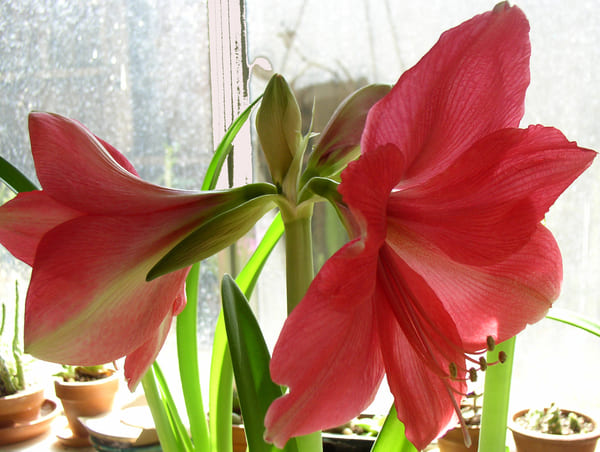
Watering
In the early growing season, a little watering is important. But after the appearance of the peduncle and before the formation of the first flowers, it is abundant. At the same time, the plant cannot be poured. It is advisable to pour water into a tray so that the flower can take as much liquid as needed.
Hippeastrum is saturated with moisture from the last days of January. It is imperative to control that the liquid penetrates into the ground and does not touch the bulb.
Air humidity
Hippeastrum is not whimsical to the parameters of humidity. That is, it is not necessary to purchase a moisturizer, it is enough to provide other conditions for the life of a flower. Optimum humidity -50%
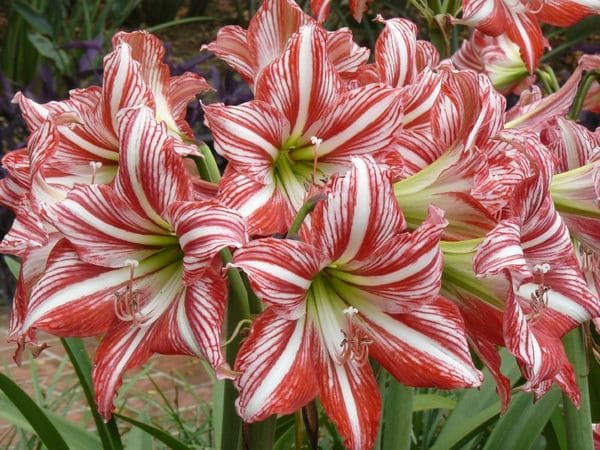
When do you need support?
Support is required when the plant has released a large arrow. The flower is supported by arched, straight or spiral columns. It can be made of bamboo, metal-plastic or just plastic.
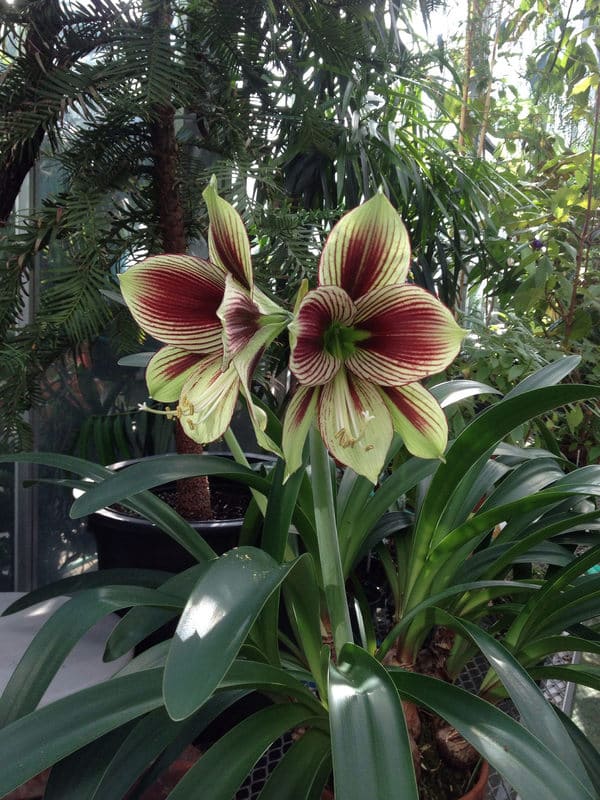
Choosing a place where to put
During the growing season, the hippeastrum needs bright lighting. It is best to place it on a window that “looks” to the southeast or southwest, the south window will do if there is shading
During the rest period, it is important to send the flower to a semi-dark place.
What does it look like in the interior?
Hippeastrum fits perfectly into the interior. Reddish-white flowers surrounded by candles can decorate the living room or bedroom space. Velvet scarlet flowers look good in a snow-white pot, and orange flowers in a flowerpot. A variety of colors of flowers will allow you to choose a plant for almost any interior.
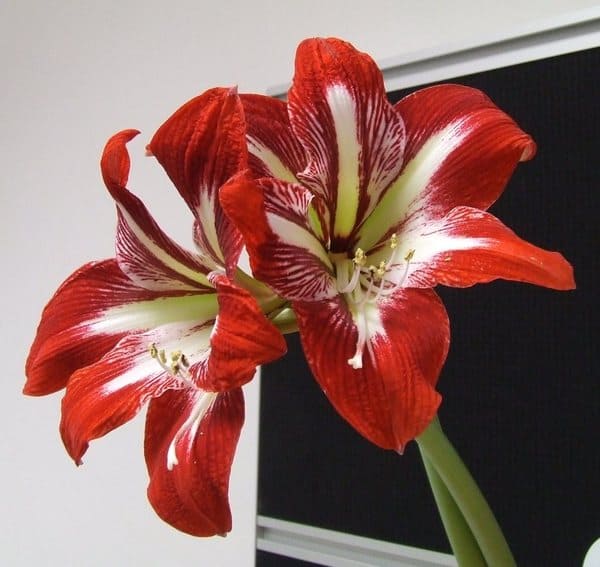
Important! the juice of the leaves of the hippeastrum is poisonous, therefore the plant should be placed in a place inaccessible to children and animals
Reproduction
Hippeastrum is propagated by seed and vegetative methods. The first is considered to be quite long, energy-consuming and ineffective, since it does not guarantee the preservation of the mother's cells by the flower. The second is the more common and effective option. He assumes two ways: reproduction by "children" or by dividing the bulb.
Seeds
Basically, the propagation of hippeastrum by seeds is chosen by breeders, because the plant must be pollinated on its own, artificially. Seedlings after a successful procedure will appear in a couple of months.
Only freshly harvested seeds give 100% germination
Therefore, it is important to guess the timing in order to plant them in the sandy-deciduous soil in the spring. Seedlings will appear in about 15-20 days
A plant grown in this way will flower in about the fourth to fifth year.
"Children"
Peculiarities. This is the natural and therefore the most favorable way. Three-year-old hippeastrum bulbs, with proper care, give three "babies" that grow on the sides of the mother's bulb. We transplant "children" in five stages.
- Carefully separate the small bulbs from the main bulbs.
- Sprinkle the place of separation with charcoal or activated carbon or ash.
- We plant in the prepared soil, deepening the bulbs to half their height.
- Until the first leaves appear (one and a half to two months), we keep the soil moist. These are optimal conditions for the formation of a strong root system.
- Transplant the bulbs with young leaves into separate pots.
If the bulb dries up for some reason or, conversely, rots, try to save the plant. To do this, cut off all healthy, juicy scales, disinfect them in a fungicide solution, plant them in prepared loose soil, water and cover with polyethylene to create a greenhouse effect. The first shoots will hatch in 10-14 days. Thus, new bulbs can be obtained without roots.
By dividing the bulb
Florists are increasingly practicing this method of breeding hippeastrum.However, this method is quite risky, as an infection can get into the wound (incision site). In this case, the transplant involves the following five steps.
- We choose an adult, healthy bulb.
- Cut in half, leaving equal parts of scales and roots on each slice.
- Sprinkle the fresh cut with charcoal.
- We plant the halves in a peat substrate.
- After the appearance of the "kids" (maxims after a couple of months) we put them in separate containers.
Depending on the size of the bulb, it can be divided into more parts (up to 16). Their width should be 1-2 cm.
Growing hippeastrum at home has its own specific characteristics, but novice florists may well master the features of the care and reproduction of this beautiful decorative flower. If you decide to grow a full-fledged flowering plant yourself from daughter bulbs, be patient. For the first two years, the young hippeastrum is not deprived of its foliage and is not sent to rest: the growth of the bulb and the formation of buds in it will depend on the intensity of the growth of the leaves. Hippeastrum will delight you with the first flowers of extraordinary beauty, towering above the succulent leaves in three years.
Features of seasonal care
Note to flower growers:
- second half of September to the end of January. Dormant period, the plant is resting. It is useful to move the flowerpot in a not damp, cool and dark room for a couple of months so that large buds are tied. Watering is not carried out, top dressing is excluded;
- from March to May - the period of active growing season. The bulb sprouts, you need to resume watering, be sure to return the flowerpot to its usual place: temperature + 17 ... + 25 ° С, diffused light, enough fresh air, but no drafts. Phosphorus fertilizers are introduced for the development of green mass;
- from July to the end of August. The period of ejection of buds and flowering. Fertilizers: phosphorus and potash, abundant watering and control of soil moisture are required to avoid stagnation of the liquid. Temperature - no higher than + 25 ° С, so that the room is not too hot. Ordinary blinds save from the scorching rays of the sun. In process of flowering, wilted buds are removed. At the end of August, watering is not so active: it's time to prepare an indoor flower for a dormant period;
- from early to mid-September. Watering is stopped, the rest period will come soon. Be sure to cut the peduncle, remove all the leaves, remove the bulb in the flowerpot in a dry, dark room with a temperature of about +12 degrees for wintering and rest before flowering.
Diseases and pests of the flower
Hippeastrum pests are thrips, scale insects, onion mites and daffodils. Treatment with insecticides helps to fight them. The hippeastrum is often damaged by rot and fungal infections. The best prevention is limited watering. Traces of rot, fungal diseases are usually found during transplantation. It is necessary to cut off the affected areas with a sharp knife and treat with fungicides. The planting of such bulbs will have to be postponed for 2 to 3 days in order for them to dry. Stagnanosporosis or a red burn is a red fungus. Most often appears when planting a purchased infected bulb. It is difficult to cure such a plant, so you need to carefully examine the planting material. If the bulb is covered with red spots, you should refrain from buying.
If roots are missing, the plant may have been flooded. In this case, it is necessary:
- cut off leaves and remnants of roots;
- treat with Fundazole and dry;
- send to rest for 2 - 3 months;
- process with Kornevin;
- plant in fresh soil mixed with sand or vermiculite;
- put in a lighted warm place.
Watering such an onion is rarely necessary. We'll have to be patient: the roots may appear only after a few months.
Video instruction for transplanting Hippeastrum:
Reproduction of hippeastrum
An indoor plant is propagated in two ways:
- Seminal. Sowing of seeds occurs immediately after collection, otherwise the degree of their germination will decrease.To make them germinate quickly, they are wrapped in a damp cloth, which is closed in a container and placed in a warm place for 10 days. The hatched seeds are poured into the prepared substrate. The pits are made 2-3 cm deep. The first shoots can be expected in two weeks. They will need a well-lit place. When several leaves appear on the shoots of the "kids", they are transplanted into separate pots. Subsequent care consists in moderate watering and dressing, which feed the soil until the end of summer.
- Vegetative. The maternal traits of the plant are better preserved when propagated by children. The bulbs must be at least 2 cm long and have developed roots. Their separation from the mother bulb occurs when a flower is transplanted. The bulbs are planted in a common container with ready-made soil. For two years they grow in a well-lit room and are watered regularly. In winter, watering is reduced. In the third year, the "kids" are planted in separate pots and are looked after as an adult plant.
To stimulate the formation of "children", the onion is cut into 4 parts. The sections are processed with charcoal powder and then dried for 3-4 days. Then the bulb is placed in a container with a mixture of peat and sand. Watering is done through the pallet until the "kids" appear.
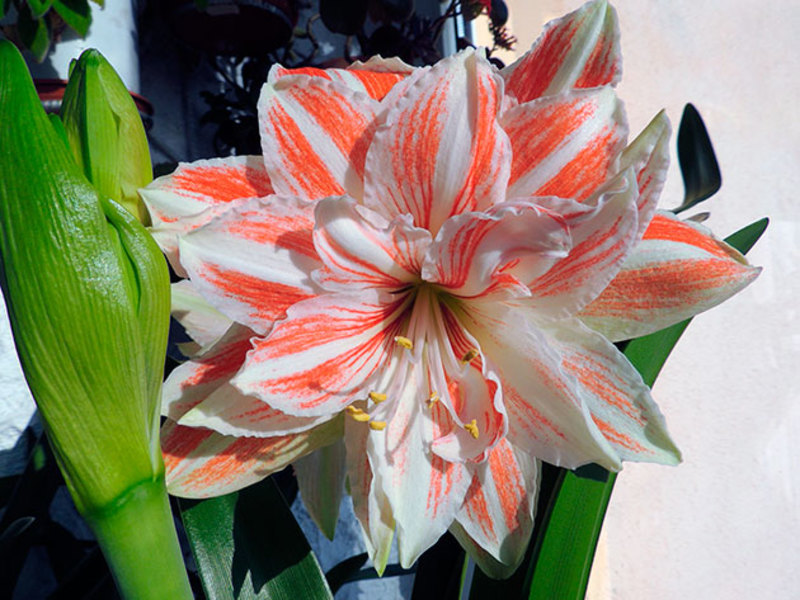

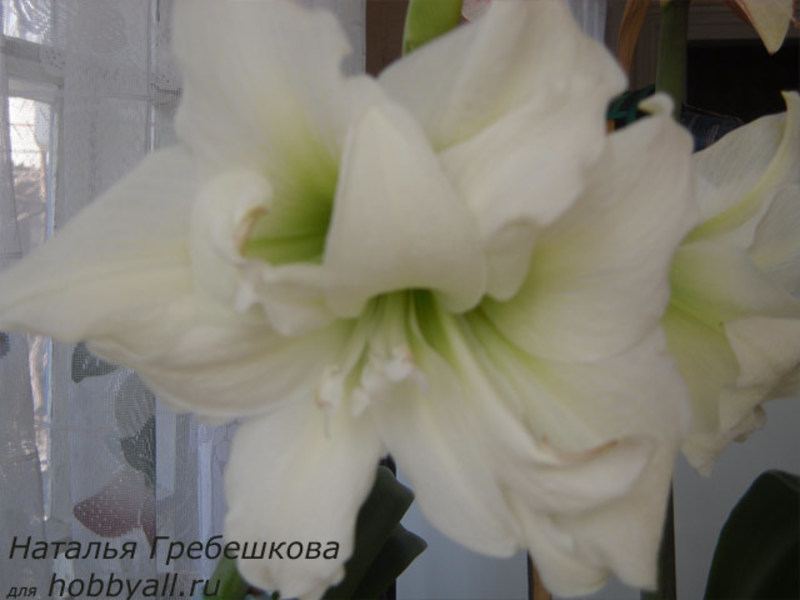
6 Secrets of flowering
It happens that the hippeastrum refuses to bloom. This is most often caused by weakening of the bulb caused by:
- absence or a very short period of rest;
- depletion of the soil, which occurred in the absence of fertilizing and replanting;
- the formation of a large number of children on the bulb;
- gross and prolonged violation of the conditions for keeping a flower;
- damage by pests.
Some secrets will help to cause flowering:
- 1. Before planting, the onion is soaked in warm (43–45 ºC) water for 3 hours. The peduncle will appear after 3 weeks.
- 2. In August, they stop watering the flower and put it in a dry and dark place until the end of January. The resumption of watering stimulates the appearance of flowering after 1.5 months.
- 3. Cutting off the leaves in July and not wetting the plant until the end of the month, you can cause flowering at the end of August, if you feed with liquid complex fertilizer with the first watering.
A little attention and work, and hippeastrum will surprise you with the beauty of its flowering.
Answers to popular questions
Why is it growing poorly?
This problem occurs when the plant was not sent to rest on time or the conditions of this period were not met. However, it so happens that the gardener adhered to all the rules, and the hippeastrum never grows. Perhaps the rhythms of the flower have changed. If this is the case, then it is necessary to give the bulb time to recover on its own. Until this moment, remove all new children so as not to overload her.
Why doesn't it give new shoots?
Several mistakes are possible here. Either the plant is not fed, watered incorrectly or not provided with good lighting, or the rules of care during flowering and during rest were not followed.
How often does it bloom?
The plant usually blooms once a year (at any time except summer), but with good care it pleases with flowers and the hot season. The timing of flowering is determined by the characteristics of care (when the bulb was sent to rest) and the type of flower.
Peculiarities
The flower has its own annual cycle. However, the time of its flowering can be artificially shifted to the desired time. This is one of the main reasons for its popularity. With proper handling, hippeastrum will delight you with blossoming buds on the appointed day. A flowering plant will be a pleasant addition to any holiday. Even in winter, when most of the plants are asleep, you can admire the bright natural flowers.
We recommend viewing: Sturon onion - variety description, reviews and cultivation features
Flowering lasts ten days. Moreover, it will not be possible to make an exhausted bulb bloom, which did not have time to recover. Distillation drains it greatly, so regular, abundant feeding will be required. In summer, it is advisable to dig the bulbs in the garden.

